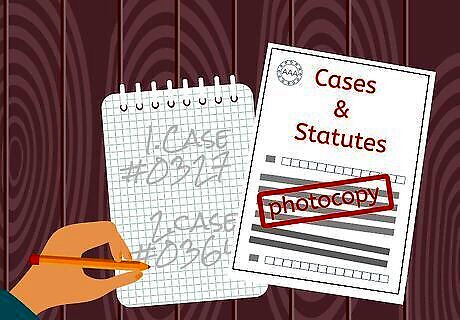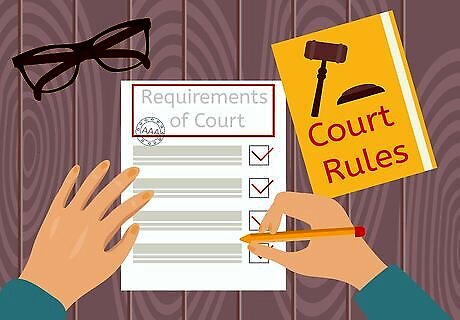
views
Finding the Requirements

Base your brief preparation on the particular court that’s hearing your case. This will determine the requirements for how you’ll compose your brief. Your case will either be in federal or state court. The federal court system encompasses Federal District Courts, Federal Courts of Appeal, and the United States Supreme Court. State court systems usually have trial courts (sometimes called Superior Courts or Circuit Courts), appellate courts, and the state supreme court.

Establish the reason for the brief. Briefs are normally either trial briefs or appellate briefs. There will probably be different rules governing each, so the necessary elements of the brief will depend on whether you’re using it for a trial or an appeal. A trial brief is provided to a judge as a written presentation of the facts and law that you feel backs up your argument as to why you should win your case. (In a trial, if you're the person who started the lawsuit you're known as the "plaintiff". If you're the one being sued, you're called the "defendant".) An appellate brief comes into play primarily when someone has lost a trial, and wants a higher court to overturn (reverse) the decision. (This is known as an “appeal”.) The purpose of the appellate brief is: To convince the higher court that the trial court’s decision was wrong (if you’re the person—known as the “appellant” or "petitioner"—who lost the case and is appealing the decision), or To defend the trial court’s decision (if you’re the person—known as the “appellee” or "respondent"—who won the trial).

Find and follow the court rules. Whether you’re in federal court or state court, there are rules of procedure that control how a brief should be written. You’ll need to follow these rules very carefully to ensure that your brief is acceptable to the court. Federal courts usually have a website that will give you access to the court rules. For example, the rules governing federal appellate briefs can be found here. Many state courts have websites. Some may have their procedural rules posted online. If your state doesn’t provide this service, then you’ll have to check legal research sites online (some of which you may have to pay for), or go to a law library to find the rules. Most courthouses have law libraries that are open to the public.
Preparing the Contents

Make a list of the important facts in your case. This amounts to setting down the sequence of events that led to your case being in court. The facts of a particular case are what dictate which laws a court will need to apply to make a decision.

Determine the legal points you need to address. You have to identify the legal point (issue) in your case that you believe needs to be resolved. For example, you signed a contract to sell your house. But now the buyer wants to back out of the deal because the house has termites. The legal point you want to address is whether the law permits the buyer to avoid going through with the contract under these circumstances. Some other common issues you may encounter are: A neighbor’s responsibility if a tree limb, hanging over your property from his or her yard, falls and damages your house Whether a landlord who’s trying to evict you for non-payment of rent is obligated to accept your offer to pay the overdue amount A municipality’s liability for damage to your car caused by an unrepaired pothole.

Research the law. Once you know the legal points you need to deal with, you have to find the law that applies to these issues. You’ll require access to federal or state statutes, and legal cases that are similar to yours. You can find statutes (and some case law) here, as well as on your state’s official website. However, you may need more case law than is available on these sites. There are online legal research services, but normally you have to pay to use them. The alternative is to go to a law library, where you can research online or by using the law books available there. Law librarians can help you find the research tools you need, but doing the actual research is up to you.

Compile a list of the legal cases and statutes you plan to use. Whenever you find a legal source that you believe supports your argument, you’ll have to note its citation (its name and the legal book it’s located in) to use it in your brief. You’ll also need the page number (for case law) or the section number (for a statute) of any portion of the legal source that you want to quote in your brief. Your best bet is simply to print the case or statute so you have it readily available.
Writing the Brief

Follow the court rules regarding formatting requirements. Each court’s procedural rules will tell you what kind of formatting is needed. However, some of the more standard features are: Paper: opaque and unglazed Line spacing: double-spaced for standard text; single-spaced for quotations, headings and footnotes Paper size: 8.5” x 11” Margins: one inch all around Type size: 12 point, usually Times New Roman, Arial, or Courier (The Supreme Court of The United States requires a font from the Century family) Sides of page available for text: One side only.

Prepare a Cover Page, Table of Contents, and Table of Authorities. These are the preliminary pages of the brief. The Cover Page is where you’ll list the court name, the names of the parties involved in the case, the court case number (usually known as a "docket number"), the type of brief (trial or appellate), your status (plaintiff or defendant; appellant or appellee), and your name, address, and contact information. The Table of Contents is pretty much what you’d expect. It breaks down the various sections of the brief, and indicates the page on which each section begins. The Table of Authorities is where you list the legal sources you’re referring to in your brief, such as statutes and case law citations.

Compose the body of the brief. This is the actual heart of the brief. Keep your sections concise and to the point. Some standard sections are: A Statement of Facts. This is where you’ll use the information you compiled in Part 2, Step 1, above. Lay out the facts in a logical order, basically leading from the beginning events of the case up to the time the case was filed in court. A Summary of the Argument. As the title implies, you’ll summarize how you believe the law applies to your circumstances. The Argument. Here's where you’ll be able to expand on how the law applies to the facts of your case (such as by quoting prior cases similar to yours). Usually you’ll have the word “ARGUMENT” centered, in capital letters. Below that, and single-spaced, you’ll indicate the legal point you’re making, in just a few lines. The rest of the Argument section should be double-spaced, except for quotations (single-spaced). The Conclusion. This section is typically very short. You basically tell the court what you’re asking it to do. For example, if you’re the appellant in a case, you’ll respectfully request that the appellate court reverse the decision of the trial court. The Conclusion section is also where you sign the brief.

Set your page numbering. This is known as “pagination”, and it can be a bit tricky in a brief. For example, some courts may want your preliminary pages to be numbered in lower case roman numerals, and the body of the brief to use standard numbering. Again, be guided by the court rules. You can learn more about pagination here.

Consider hiring an attorney to represent you. Brief writing and formatting can be complicated, particularly on the appellate level. Even if you represented yourself at the trial, you might want to consider retaining an attorney to represent you on an appeal.




















Comments
0 comment